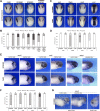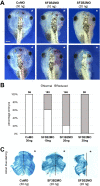Haploinsufficiency of SF3B2 causes craniofacial microsomia
- PMID: 34344887
- PMCID: PMC8333351
- DOI: 10.1038/s41467-021-24852-9
Haploinsufficiency of SF3B2 causes craniofacial microsomia
Abstract
Craniofacial microsomia (CFM) is the second most common congenital facial anomaly, yet its genetic etiology remains unknown. We perform whole-exome or genome sequencing of 146 kindreds with sporadic (n = 138) or familial (n = 8) CFM, identifying a highly significant burden of loss of function variants in SF3B2 (P = 3.8 × 10-10), a component of the U2 small nuclear ribonucleoprotein complex, in probands. We describe twenty individuals from seven kindreds harboring de novo or transmitted haploinsufficient variants in SF3B2. Probands display mandibular hypoplasia, microtia, facial and preauricular tags, epibulbar dermoids, lateral oral clefts in addition to skeletal and cardiac abnormalities. Targeted morpholino knockdown of SF3B2 in Xenopus results in disruption of cranial neural crest precursor formation and subsequent craniofacial cartilage defects, supporting a link between spliceosome mutations and impaired neural crest development in congenital craniofacial disease. The results establish haploinsufficient variants in SF3B2 as the most prevalent genetic cause of CFM, explaining ~3% of sporadic and ~25% of familial cases.
© 2021. The Author(s).
Conflict of interest statement
Rhonda E. Schnur and Sureni V. Mullegama are employees of GeneDx. The remaining authors declare no competing interest.
Figures




References
Publication types
MeSH terms
Substances
Grants and funding
LinkOut - more resources
Full Text Sources
Molecular Biology Databases

